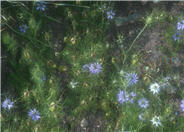
Common name:Azure or Russian Sage
Botanical name:Perovskia X atriplicifolia
This broad perennial will grow 3'-6' tall and has small, grey-green leaves with blue-violet flowers that bloom in the summer. Foliage is aromatic if brushed against it.

Common name:Common Yarrow, Mifoil
Botanical name:Achillea millefolium
Common Yarrow is a hardy perennial with hairy, evergreen green foliage. It has a tight cluster of white flowers and typically blooms in the summer months. It attracts bees and butterflies. It prefers full to part sun and becomes drought tolerant once it's established. Following bloom, one should dead head the plant and divide the clumps when it appears crowded to keep it looking tidy.

Common name:Creeping Fig
Botanical name:Ficus pumila
This is one of the few plants that can attach itself securely to wood, masonry, or metal. Because there is no limit to its size, it can overcome an entire buliding. It is most often found in colder climates. This vine will not clim on southern or western walls.

Common name:California or Golden Poppy
Botanical name:Eschscholzia californica
This small annual (sometimes acts as a perennial) plant will grow to less than 1' tall and has light, small blue-green leaves with gold and orange flowers that bloom in spring and summer.

Common name:White Bacopa
Botanical name:Sutera cordata
White Bacopa is a prostrate ground cover with white flowers. It reaches 1' tall and spreads to 2' wide. This lovely plant blooms most of the year if given ample water (otherwise, flowers drop). Leaves are small, heart shaped, aromatic and heart shaped. Plant in full sun near coastal areas; provide afternoon shade or complete shade in warm inland areas. It does better in acid, rich soil that is well draining. This is a great plant for containers and hanging baskets.

Common name:Love-In-A-Mist
Botanical name:Nigella damascena
Nigella damascena is an annual. Branching to 1'-1.5' high. All leaves are finely cut into threadlike divisons. Blue, white, or rose flowers, 1"-1.5" across bloom in spring. This beautiful annual was actually used in Elizabethan times for English cottage gardens. It looks great in window boxes and will self-seed.
We can identify at least 11 steps of sustainable landscape renovation for consideration. They include critical design, installation and maintenance practices that conform to good principles of appropriate horticulture.
Click in the green box for more information
Designer: Joe Grant
Photographer: GardenSoft
Practice grass-cycling by leaving short grass clippings on lawns after mowing, so that nutrients and organic matter are returned to the soil.
Drip and other smart irrigation delivers water directly to roots, allowing no excess water for weeds.